Approaches to Pedagogy and Curriculum in Early Childhood
VerifiedAdded on 2023/01/16
|10
|2377
|33
AI Summary
This report discusses the significance of pedagogy and curriculum in early childhood education. It explores different approaches and philosophical ideas drawn by theorists for experiential learning. The report also covers pioneers in early childhood, learning theories, post-modern theory, curriculum models, and the difference between them.
Contribute Materials
Your contribution can guide someone’s learning journey. Share your
documents today.
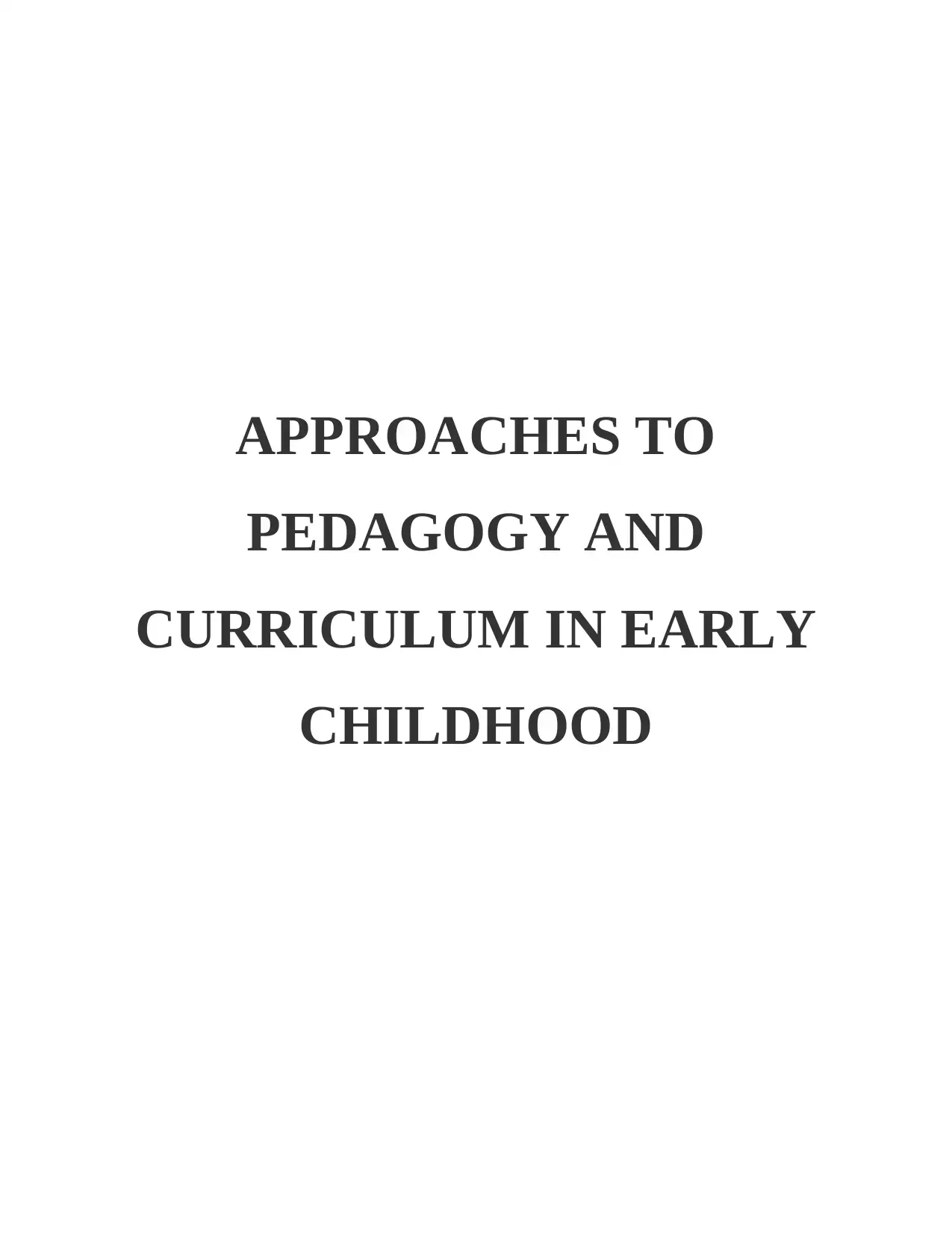
APPROACHES TO
PEDAGOGY AND
CURRICULUM IN EARLY
CHILDHOOD
PEDAGOGY AND
CURRICULUM IN EARLY
CHILDHOOD
Secure Best Marks with AI Grader
Need help grading? Try our AI Grader for instant feedback on your assignments.
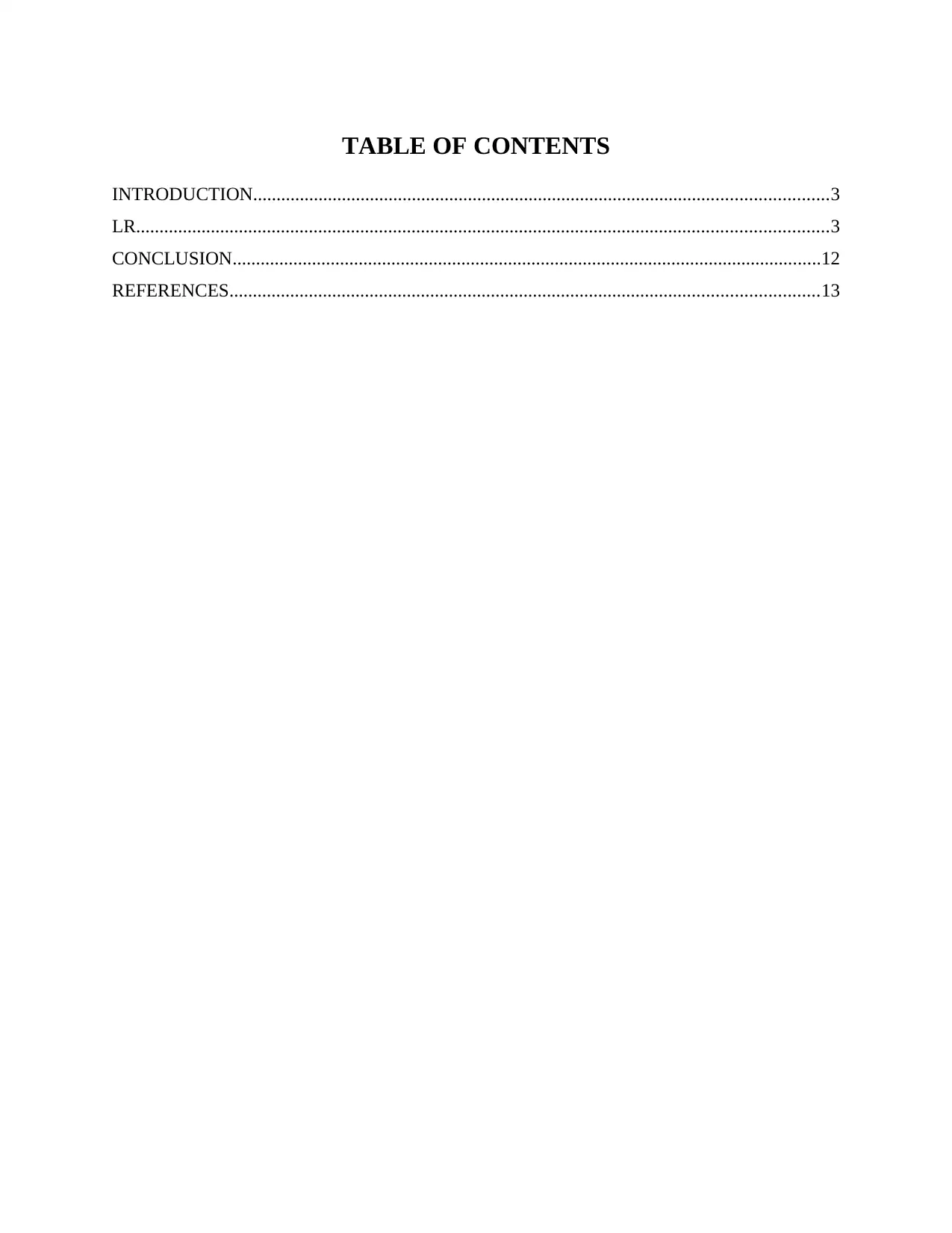
TABLE OF CONTENTS
INTRODUCTION...........................................................................................................................3
LR....................................................................................................................................................3
CONCLUSION..............................................................................................................................12
REFERENCES..............................................................................................................................13
INTRODUCTION...........................................................................................................................3
LR....................................................................................................................................................3
CONCLUSION..............................................................................................................................12
REFERENCES..............................................................................................................................13
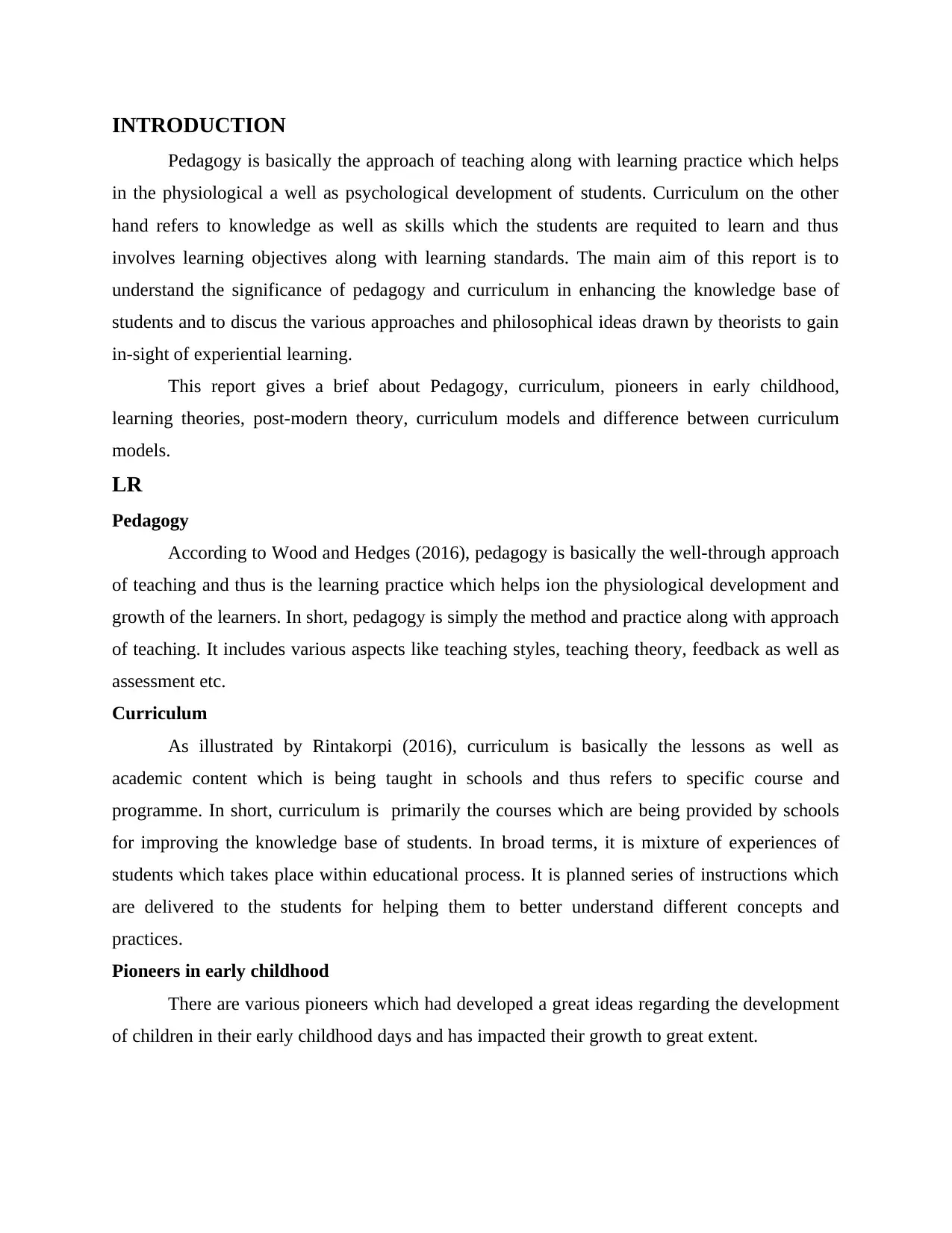
INTRODUCTION
Pedagogy is basically the approach of teaching along with learning practice which helps
in the physiological a well as psychological development of students. Curriculum on the other
hand refers to knowledge as well as skills which the students are requited to learn and thus
involves learning objectives along with learning standards. The main aim of this report is to
understand the significance of pedagogy and curriculum in enhancing the knowledge base of
students and to discus the various approaches and philosophical ideas drawn by theorists to gain
in-sight of experiential learning.
This report gives a brief about Pedagogy, curriculum, pioneers in early childhood,
learning theories, post-modern theory, curriculum models and difference between curriculum
models.
LR
Pedagogy
According to Wood and Hedges (2016), pedagogy is basically the well-through approach
of teaching and thus is the learning practice which helps ion the physiological development and
growth of the learners. In short, pedagogy is simply the method and practice along with approach
of teaching. It includes various aspects like teaching styles, teaching theory, feedback as well as
assessment etc.
Curriculum
As illustrated by Rintakorpi (2016), curriculum is basically the lessons as well as
academic content which is being taught in schools and thus refers to specific course and
programme. In short, curriculum is primarily the courses which are being provided by schools
for improving the knowledge base of students. In broad terms, it is mixture of experiences of
students which takes place within educational process. It is planned series of instructions which
are delivered to the students for helping them to better understand different concepts and
practices.
Pioneers in early childhood
There are various pioneers which had developed a great ideas regarding the development
of children in their early childhood days and has impacted their growth to great extent.
Pedagogy is basically the approach of teaching along with learning practice which helps
in the physiological a well as psychological development of students. Curriculum on the other
hand refers to knowledge as well as skills which the students are requited to learn and thus
involves learning objectives along with learning standards. The main aim of this report is to
understand the significance of pedagogy and curriculum in enhancing the knowledge base of
students and to discus the various approaches and philosophical ideas drawn by theorists to gain
in-sight of experiential learning.
This report gives a brief about Pedagogy, curriculum, pioneers in early childhood,
learning theories, post-modern theory, curriculum models and difference between curriculum
models.
LR
Pedagogy
According to Wood and Hedges (2016), pedagogy is basically the well-through approach
of teaching and thus is the learning practice which helps ion the physiological development and
growth of the learners. In short, pedagogy is simply the method and practice along with approach
of teaching. It includes various aspects like teaching styles, teaching theory, feedback as well as
assessment etc.
Curriculum
As illustrated by Rintakorpi (2016), curriculum is basically the lessons as well as
academic content which is being taught in schools and thus refers to specific course and
programme. In short, curriculum is primarily the courses which are being provided by schools
for improving the knowledge base of students. In broad terms, it is mixture of experiences of
students which takes place within educational process. It is planned series of instructions which
are delivered to the students for helping them to better understand different concepts and
practices.
Pioneers in early childhood
There are various pioneers which had developed a great ideas regarding the development
of children in their early childhood days and has impacted their growth to great extent.
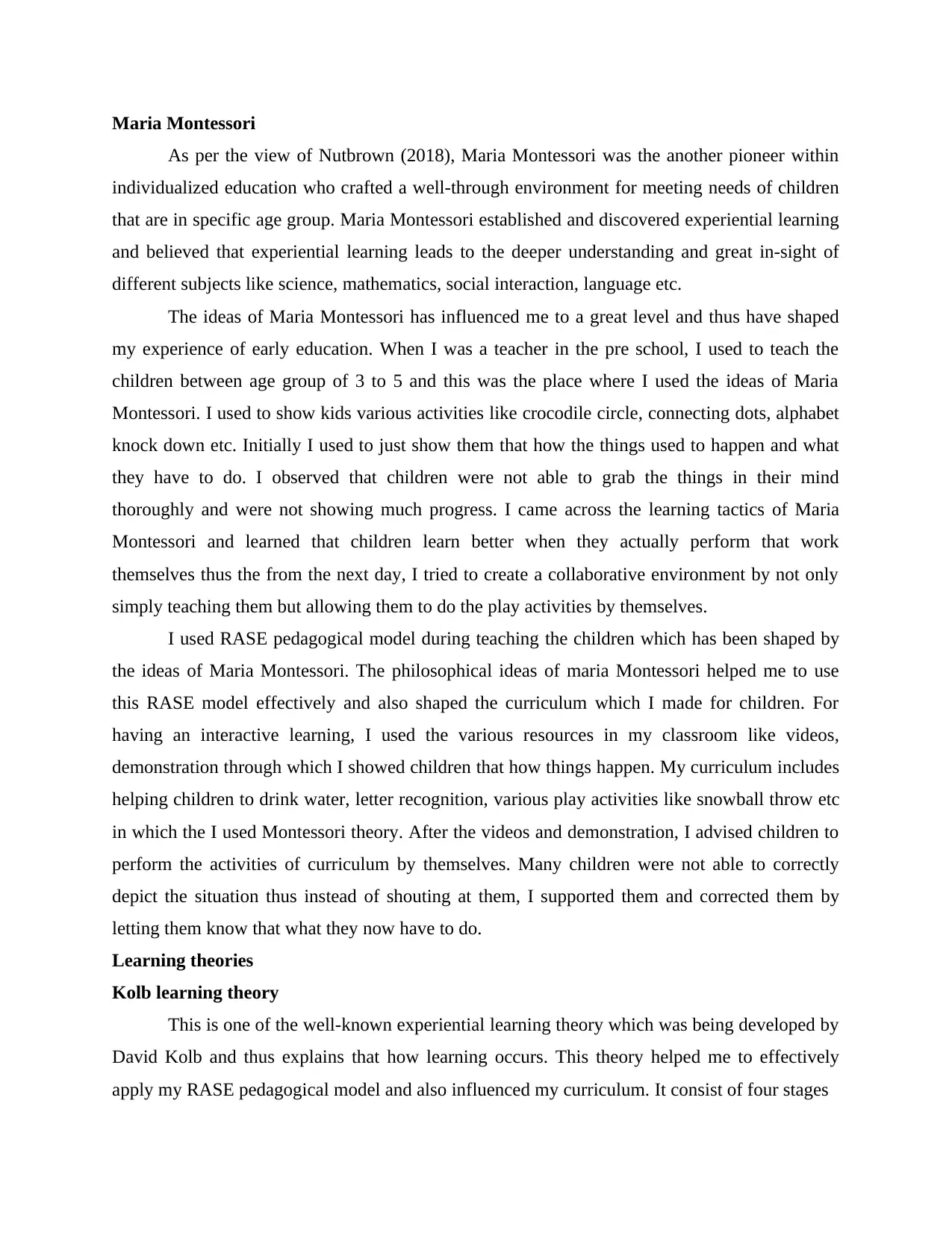
Maria Montessori
As per the view of Nutbrown (2018), Maria Montessori was the another pioneer within
individualized education who crafted a well-through environment for meeting needs of children
that are in specific age group. Maria Montessori established and discovered experiential learning
and believed that experiential learning leads to the deeper understanding and great in-sight of
different subjects like science, mathematics, social interaction, language etc.
The ideas of Maria Montessori has influenced me to a great level and thus have shaped
my experience of early education. When I was a teacher in the pre school, I used to teach the
children between age group of 3 to 5 and this was the place where I used the ideas of Maria
Montessori. I used to show kids various activities like crocodile circle, connecting dots, alphabet
knock down etc. Initially I used to just show them that how the things used to happen and what
they have to do. I observed that children were not able to grab the things in their mind
thoroughly and were not showing much progress. I came across the learning tactics of Maria
Montessori and learned that children learn better when they actually perform that work
themselves thus the from the next day, I tried to create a collaborative environment by not only
simply teaching them but allowing them to do the play activities by themselves.
I used RASE pedagogical model during teaching the children which has been shaped by
the ideas of Maria Montessori. The philosophical ideas of maria Montessori helped me to use
this RASE model effectively and also shaped the curriculum which I made for children. For
having an interactive learning, I used the various resources in my classroom like videos,
demonstration through which I showed children that how things happen. My curriculum includes
helping children to drink water, letter recognition, various play activities like snowball throw etc
in which the I used Montessori theory. After the videos and demonstration, I advised children to
perform the activities of curriculum by themselves. Many children were not able to correctly
depict the situation thus instead of shouting at them, I supported them and corrected them by
letting them know that what they now have to do.
Learning theories
Kolb learning theory
This is one of the well-known experiential learning theory which was being developed by
David Kolb and thus explains that how learning occurs. This theory helped me to effectively
apply my RASE pedagogical model and also influenced my curriculum. It consist of four stages
As per the view of Nutbrown (2018), Maria Montessori was the another pioneer within
individualized education who crafted a well-through environment for meeting needs of children
that are in specific age group. Maria Montessori established and discovered experiential learning
and believed that experiential learning leads to the deeper understanding and great in-sight of
different subjects like science, mathematics, social interaction, language etc.
The ideas of Maria Montessori has influenced me to a great level and thus have shaped
my experience of early education. When I was a teacher in the pre school, I used to teach the
children between age group of 3 to 5 and this was the place where I used the ideas of Maria
Montessori. I used to show kids various activities like crocodile circle, connecting dots, alphabet
knock down etc. Initially I used to just show them that how the things used to happen and what
they have to do. I observed that children were not able to grab the things in their mind
thoroughly and were not showing much progress. I came across the learning tactics of Maria
Montessori and learned that children learn better when they actually perform that work
themselves thus the from the next day, I tried to create a collaborative environment by not only
simply teaching them but allowing them to do the play activities by themselves.
I used RASE pedagogical model during teaching the children which has been shaped by
the ideas of Maria Montessori. The philosophical ideas of maria Montessori helped me to use
this RASE model effectively and also shaped the curriculum which I made for children. For
having an interactive learning, I used the various resources in my classroom like videos,
demonstration through which I showed children that how things happen. My curriculum includes
helping children to drink water, letter recognition, various play activities like snowball throw etc
in which the I used Montessori theory. After the videos and demonstration, I advised children to
perform the activities of curriculum by themselves. Many children were not able to correctly
depict the situation thus instead of shouting at them, I supported them and corrected them by
letting them know that what they now have to do.
Learning theories
Kolb learning theory
This is one of the well-known experiential learning theory which was being developed by
David Kolb and thus explains that how learning occurs. This theory helped me to effectively
apply my RASE pedagogical model and also influenced my curriculum. It consist of four stages
Secure Best Marks with AI Grader
Need help grading? Try our AI Grader for instant feedback on your assignments.
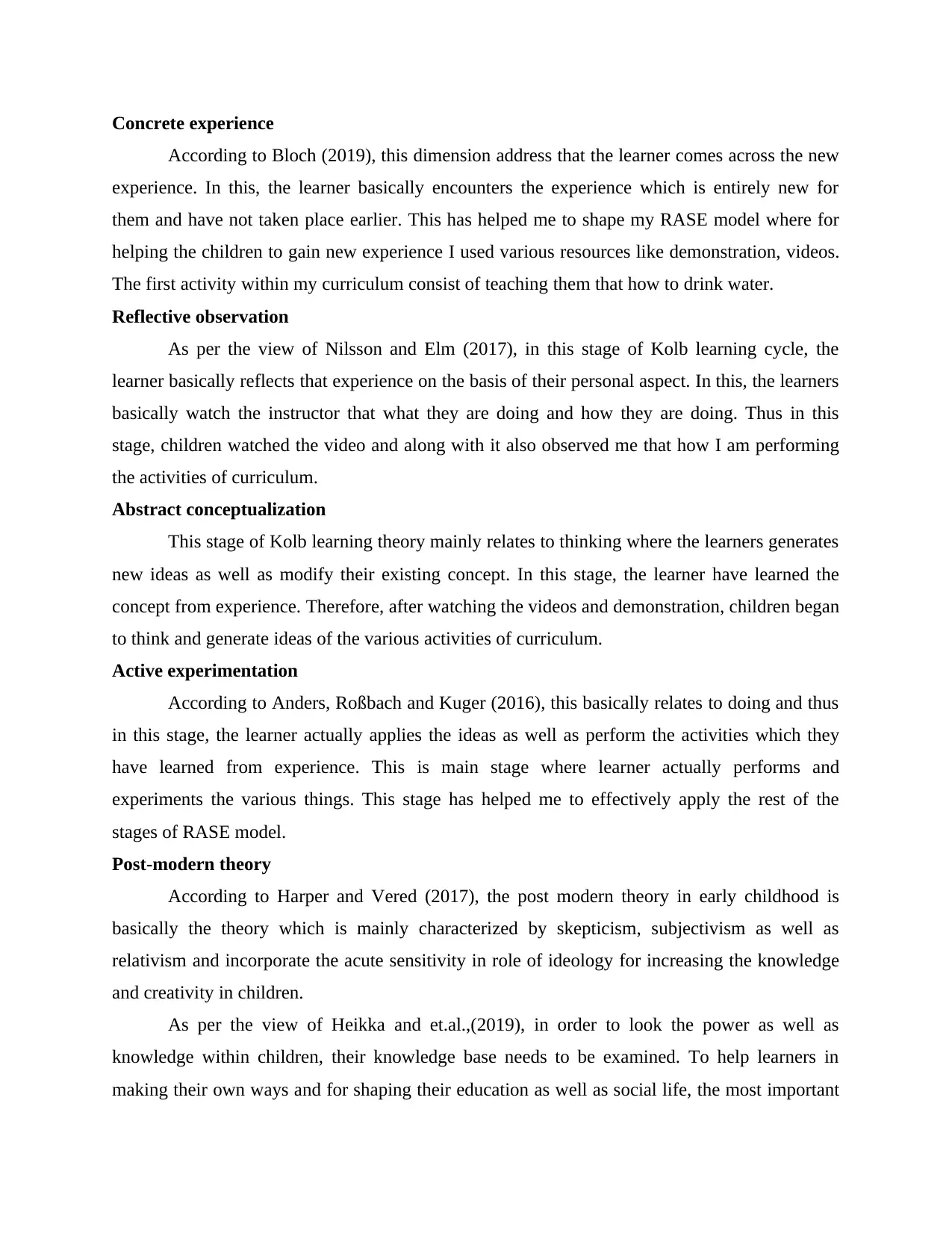
Concrete experience
According to Bloch (2019), this dimension address that the learner comes across the new
experience. In this, the learner basically encounters the experience which is entirely new for
them and have not taken place earlier. This has helped me to shape my RASE model where for
helping the children to gain new experience I used various resources like demonstration, videos.
The first activity within my curriculum consist of teaching them that how to drink water.
Reflective observation
As per the view of Nilsson and Elm (2017), in this stage of Kolb learning cycle, the
learner basically reflects that experience on the basis of their personal aspect. In this, the learners
basically watch the instructor that what they are doing and how they are doing. Thus in this
stage, children watched the video and along with it also observed me that how I am performing
the activities of curriculum.
Abstract conceptualization
This stage of Kolb learning theory mainly relates to thinking where the learners generates
new ideas as well as modify their existing concept. In this stage, the learner have learned the
concept from experience. Therefore, after watching the videos and demonstration, children began
to think and generate ideas of the various activities of curriculum.
Active experimentation
According to Anders, Roßbach and Kuger (2016), this basically relates to doing and thus
in this stage, the learner actually applies the ideas as well as perform the activities which they
have learned from experience. This is main stage where learner actually performs and
experiments the various things. This stage has helped me to effectively apply the rest of the
stages of RASE model.
Post-modern theory
According to Harper and Vered (2017), the post modern theory in early childhood is
basically the theory which is mainly characterized by skepticism, subjectivism as well as
relativism and incorporate the acute sensitivity in role of ideology for increasing the knowledge
and creativity in children.
As per the view of Heikka and et.al.,(2019), in order to look the power as well as
knowledge within children, their knowledge base needs to be examined. To help learners in
making their own ways and for shaping their education as well as social life, the most important
According to Bloch (2019), this dimension address that the learner comes across the new
experience. In this, the learner basically encounters the experience which is entirely new for
them and have not taken place earlier. This has helped me to shape my RASE model where for
helping the children to gain new experience I used various resources like demonstration, videos.
The first activity within my curriculum consist of teaching them that how to drink water.
Reflective observation
As per the view of Nilsson and Elm (2017), in this stage of Kolb learning cycle, the
learner basically reflects that experience on the basis of their personal aspect. In this, the learners
basically watch the instructor that what they are doing and how they are doing. Thus in this
stage, children watched the video and along with it also observed me that how I am performing
the activities of curriculum.
Abstract conceptualization
This stage of Kolb learning theory mainly relates to thinking where the learners generates
new ideas as well as modify their existing concept. In this stage, the learner have learned the
concept from experience. Therefore, after watching the videos and demonstration, children began
to think and generate ideas of the various activities of curriculum.
Active experimentation
According to Anders, Roßbach and Kuger (2016), this basically relates to doing and thus
in this stage, the learner actually applies the ideas as well as perform the activities which they
have learned from experience. This is main stage where learner actually performs and
experiments the various things. This stage has helped me to effectively apply the rest of the
stages of RASE model.
Post-modern theory
According to Harper and Vered (2017), the post modern theory in early childhood is
basically the theory which is mainly characterized by skepticism, subjectivism as well as
relativism and incorporate the acute sensitivity in role of ideology for increasing the knowledge
and creativity in children.
As per the view of Heikka and et.al.,(2019), in order to look the power as well as
knowledge within children, their knowledge base needs to be examined. To help learners in
making their own ways and for shaping their education as well as social life, the most important
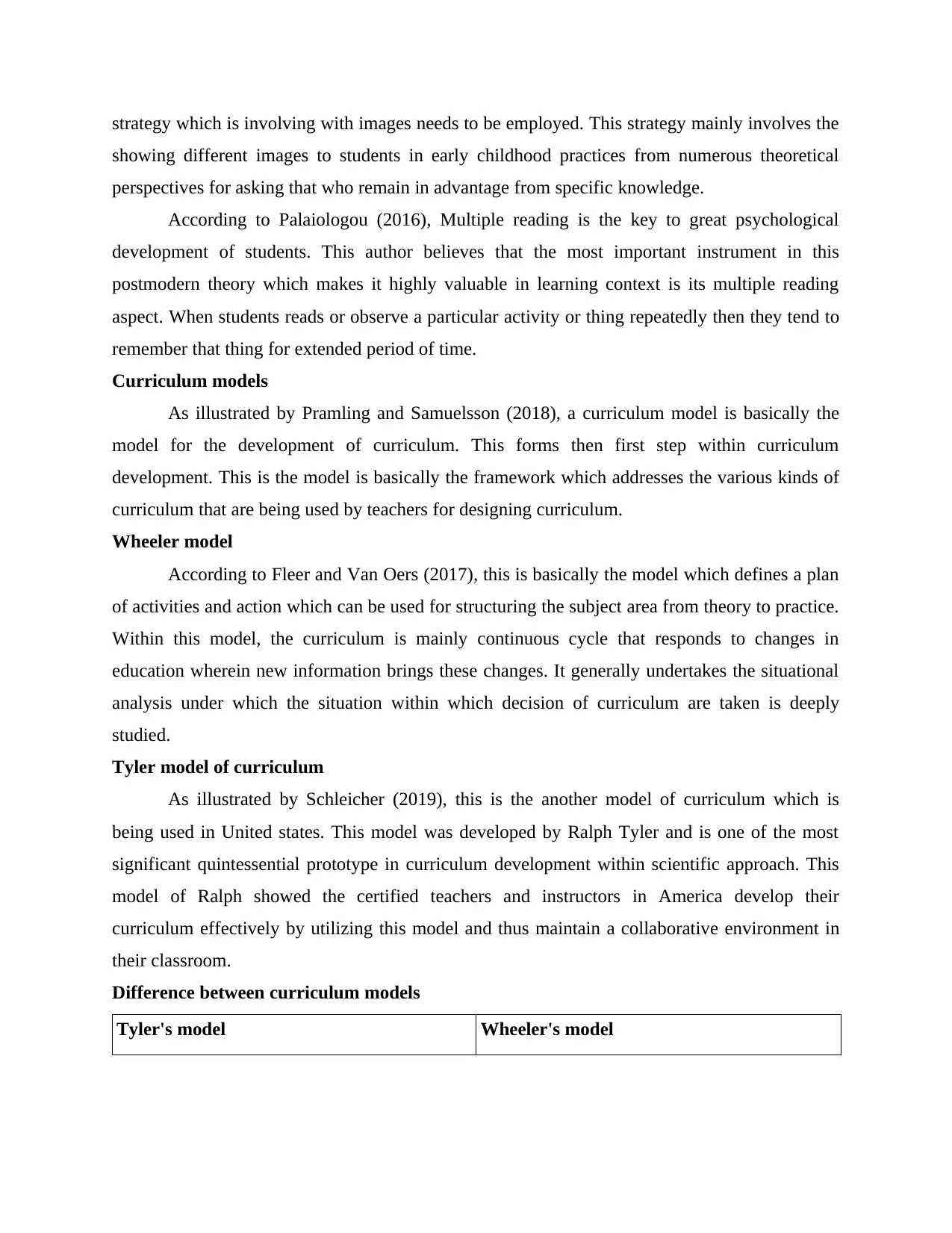
strategy which is involving with images needs to be employed. This strategy mainly involves the
showing different images to students in early childhood practices from numerous theoretical
perspectives for asking that who remain in advantage from specific knowledge.
According to Palaiologou (2016), Multiple reading is the key to great psychological
development of students. This author believes that the most important instrument in this
postmodern theory which makes it highly valuable in learning context is its multiple reading
aspect. When students reads or observe a particular activity or thing repeatedly then they tend to
remember that thing for extended period of time.
Curriculum models
As illustrated by Pramling and Samuelsson (2018), a curriculum model is basically the
model for the development of curriculum. This forms then first step within curriculum
development. This is the model is basically the framework which addresses the various kinds of
curriculum that are being used by teachers for designing curriculum.
Wheeler model
According to Fleer and Van Oers (2017), this is basically the model which defines a plan
of activities and action which can be used for structuring the subject area from theory to practice.
Within this model, the curriculum is mainly continuous cycle that responds to changes in
education wherein new information brings these changes. It generally undertakes the situational
analysis under which the situation within which decision of curriculum are taken is deeply
studied.
Tyler model of curriculum
As illustrated by Schleicher (2019), this is the another model of curriculum which is
being used in United states. This model was developed by Ralph Tyler and is one of the most
significant quintessential prototype in curriculum development within scientific approach. This
model of Ralph showed the certified teachers and instructors in America develop their
curriculum effectively by utilizing this model and thus maintain a collaborative environment in
their classroom.
Difference between curriculum models
Tyler's model Wheeler's model
showing different images to students in early childhood practices from numerous theoretical
perspectives for asking that who remain in advantage from specific knowledge.
According to Palaiologou (2016), Multiple reading is the key to great psychological
development of students. This author believes that the most important instrument in this
postmodern theory which makes it highly valuable in learning context is its multiple reading
aspect. When students reads or observe a particular activity or thing repeatedly then they tend to
remember that thing for extended period of time.
Curriculum models
As illustrated by Pramling and Samuelsson (2018), a curriculum model is basically the
model for the development of curriculum. This forms then first step within curriculum
development. This is the model is basically the framework which addresses the various kinds of
curriculum that are being used by teachers for designing curriculum.
Wheeler model
According to Fleer and Van Oers (2017), this is basically the model which defines a plan
of activities and action which can be used for structuring the subject area from theory to practice.
Within this model, the curriculum is mainly continuous cycle that responds to changes in
education wherein new information brings these changes. It generally undertakes the situational
analysis under which the situation within which decision of curriculum are taken is deeply
studied.
Tyler model of curriculum
As illustrated by Schleicher (2019), this is the another model of curriculum which is
being used in United states. This model was developed by Ralph Tyler and is one of the most
significant quintessential prototype in curriculum development within scientific approach. This
model of Ralph showed the certified teachers and instructors in America develop their
curriculum effectively by utilizing this model and thus maintain a collaborative environment in
their classroom.
Difference between curriculum models
Tyler's model Wheeler's model
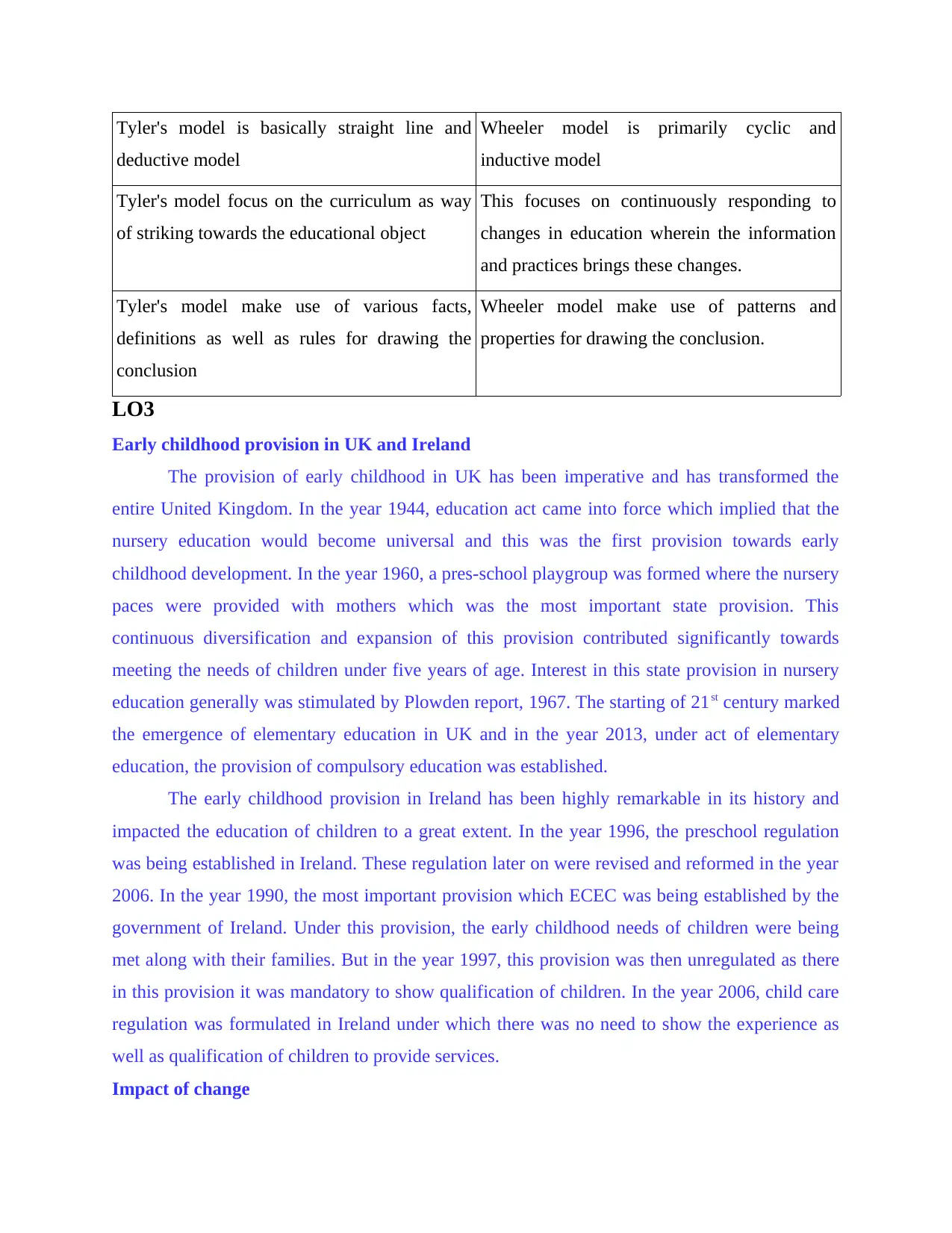
Tyler's model is basically straight line and
deductive model
Wheeler model is primarily cyclic and
inductive model
Tyler's model focus on the curriculum as way
of striking towards the educational object
This focuses on continuously responding to
changes in education wherein the information
and practices brings these changes.
Tyler's model make use of various facts,
definitions as well as rules for drawing the
conclusion
Wheeler model make use of patterns and
properties for drawing the conclusion.
LO3
Early childhood provision in UK and Ireland
The provision of early childhood in UK has been imperative and has transformed the
entire United Kingdom. In the year 1944, education act came into force which implied that the
nursery education would become universal and this was the first provision towards early
childhood development. In the year 1960, a pres-school playgroup was formed where the nursery
paces were provided with mothers which was the most important state provision. This
continuous diversification and expansion of this provision contributed significantly towards
meeting the needs of children under five years of age. Interest in this state provision in nursery
education generally was stimulated by Plowden report, 1967. The starting of 21st century marked
the emergence of elementary education in UK and in the year 2013, under act of elementary
education, the provision of compulsory education was established.
The early childhood provision in Ireland has been highly remarkable in its history and
impacted the education of children to a great extent. In the year 1996, the preschool regulation
was being established in Ireland. These regulation later on were revised and reformed in the year
2006. In the year 1990, the most important provision which ECEC was being established by the
government of Ireland. Under this provision, the early childhood needs of children were being
met along with their families. But in the year 1997, this provision was then unregulated as there
in this provision it was mandatory to show qualification of children. In the year 2006, child care
regulation was formulated in Ireland under which there was no need to show the experience as
well as qualification of children to provide services.
Impact of change
deductive model
Wheeler model is primarily cyclic and
inductive model
Tyler's model focus on the curriculum as way
of striking towards the educational object
This focuses on continuously responding to
changes in education wherein the information
and practices brings these changes.
Tyler's model make use of various facts,
definitions as well as rules for drawing the
conclusion
Wheeler model make use of patterns and
properties for drawing the conclusion.
LO3
Early childhood provision in UK and Ireland
The provision of early childhood in UK has been imperative and has transformed the
entire United Kingdom. In the year 1944, education act came into force which implied that the
nursery education would become universal and this was the first provision towards early
childhood development. In the year 1960, a pres-school playgroup was formed where the nursery
paces were provided with mothers which was the most important state provision. This
continuous diversification and expansion of this provision contributed significantly towards
meeting the needs of children under five years of age. Interest in this state provision in nursery
education generally was stimulated by Plowden report, 1967. The starting of 21st century marked
the emergence of elementary education in UK and in the year 2013, under act of elementary
education, the provision of compulsory education was established.
The early childhood provision in Ireland has been highly remarkable in its history and
impacted the education of children to a great extent. In the year 1996, the preschool regulation
was being established in Ireland. These regulation later on were revised and reformed in the year
2006. In the year 1990, the most important provision which ECEC was being established by the
government of Ireland. Under this provision, the early childhood needs of children were being
met along with their families. But in the year 1997, this provision was then unregulated as there
in this provision it was mandatory to show qualification of children. In the year 2006, child care
regulation was formulated in Ireland under which there was no need to show the experience as
well as qualification of children to provide services.
Impact of change
Paraphrase This Document
Need a fresh take? Get an instant paraphrase of this document with our AI Paraphraser
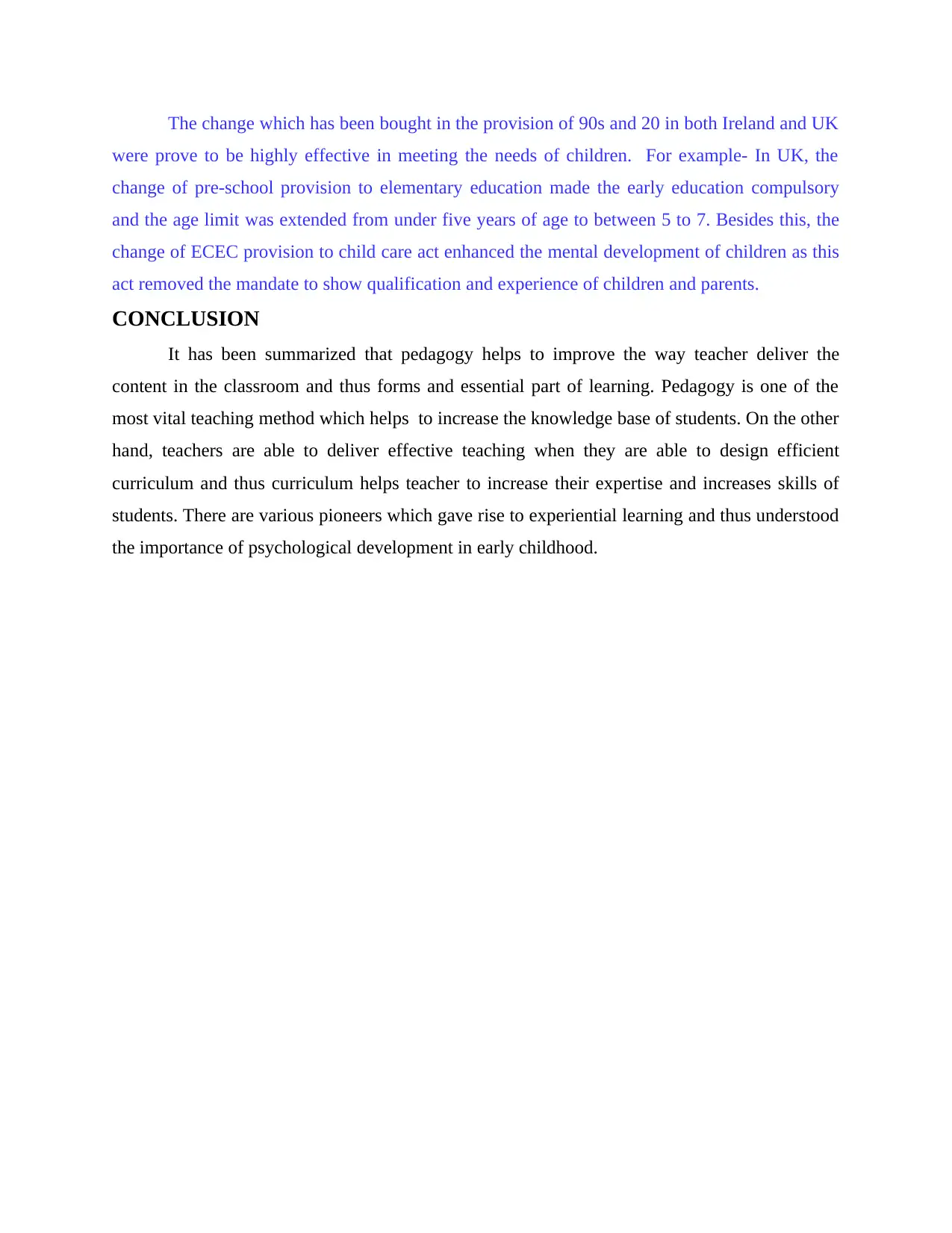
The change which has been bought in the provision of 90s and 20 in both Ireland and UK
were prove to be highly effective in meeting the needs of children. For example- In UK, the
change of pre-school provision to elementary education made the early education compulsory
and the age limit was extended from under five years of age to between 5 to 7. Besides this, the
change of ECEC provision to child care act enhanced the mental development of children as this
act removed the mandate to show qualification and experience of children and parents.
CONCLUSION
It has been summarized that pedagogy helps to improve the way teacher deliver the
content in the classroom and thus forms and essential part of learning. Pedagogy is one of the
most vital teaching method which helps to increase the knowledge base of students. On the other
hand, teachers are able to deliver effective teaching when they are able to design efficient
curriculum and thus curriculum helps teacher to increase their expertise and increases skills of
students. There are various pioneers which gave rise to experiential learning and thus understood
the importance of psychological development in early childhood.
were prove to be highly effective in meeting the needs of children. For example- In UK, the
change of pre-school provision to elementary education made the early education compulsory
and the age limit was extended from under five years of age to between 5 to 7. Besides this, the
change of ECEC provision to child care act enhanced the mental development of children as this
act removed the mandate to show qualification and experience of children and parents.
CONCLUSION
It has been summarized that pedagogy helps to improve the way teacher deliver the
content in the classroom and thus forms and essential part of learning. Pedagogy is one of the
most vital teaching method which helps to increase the knowledge base of students. On the other
hand, teachers are able to deliver effective teaching when they are able to design efficient
curriculum and thus curriculum helps teacher to increase their expertise and increases skills of
students. There are various pioneers which gave rise to experiential learning and thus understood
the importance of psychological development in early childhood.
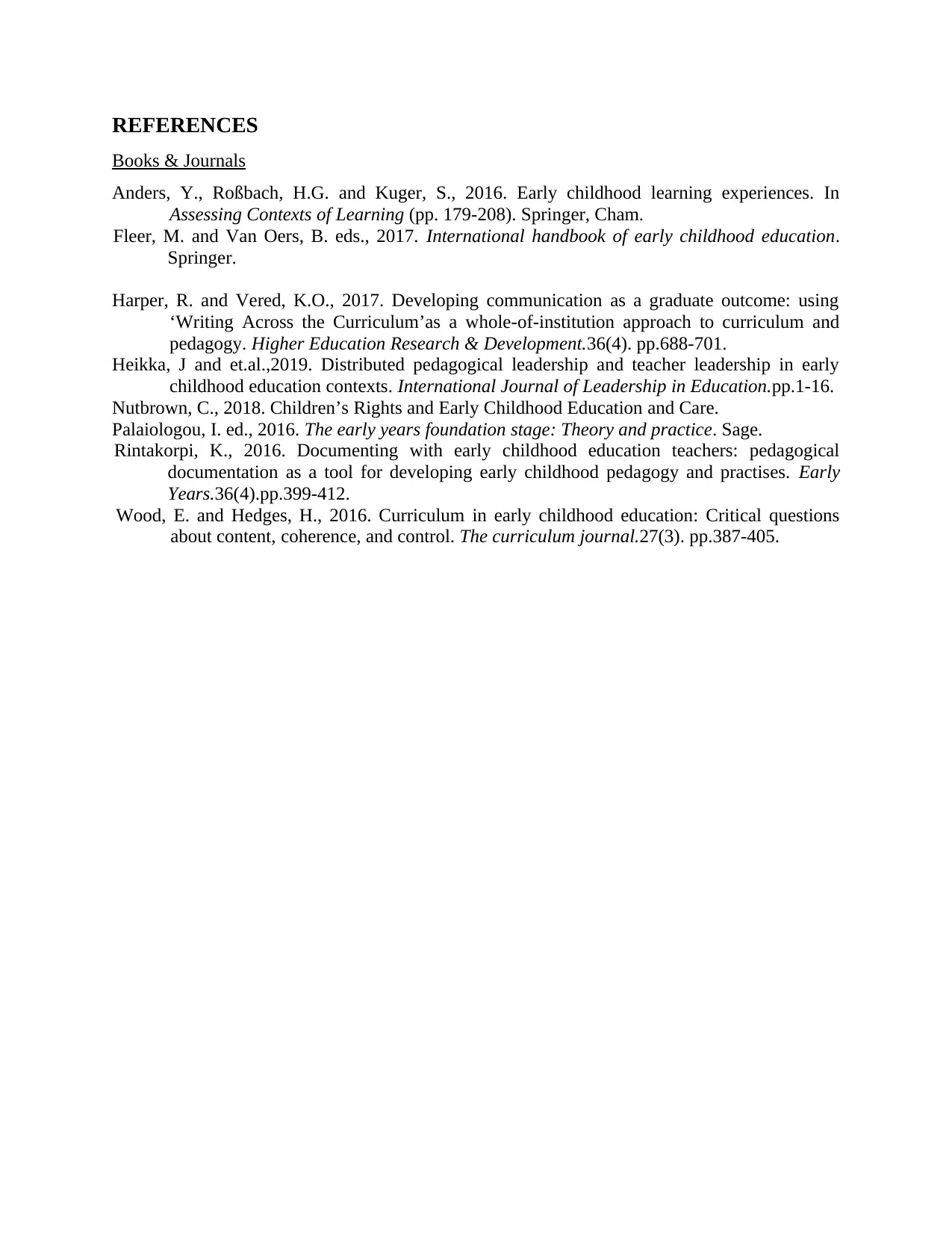
REFERENCES
Books & Journals
Anders, Y., Roßbach, H.G. and Kuger, S., 2016. Early childhood learning experiences. In
Assessing Contexts of Learning (pp. 179-208). Springer, Cham.
Fleer, M. and Van Oers, B. eds., 2017. International handbook of early childhood education.
Springer.
Harper, R. and Vered, K.O., 2017. Developing communication as a graduate outcome: using
‘Writing Across the Curriculum’as a whole-of-institution approach to curriculum and
pedagogy. Higher Education Research & Development.36(4). pp.688-701.
Heikka, J and et.al.,2019. Distributed pedagogical leadership and teacher leadership in early
childhood education contexts. International Journal of Leadership in Education.pp.1-16.
Nutbrown, C., 2018. Children’s Rights and Early Childhood Education and Care.
Palaiologou, I. ed., 2016. The early years foundation stage: Theory and practice. Sage.
Rintakorpi, K., 2016. Documenting with early childhood education teachers: pedagogical
documentation as a tool for developing early childhood pedagogy and practises. Early
Years.36(4).pp.399-412.
Wood, E. and Hedges, H., 2016. Curriculum in early childhood education: Critical questions
about content, coherence, and control. The curriculum journal.27(3). pp.387-405.
Books & Journals
Anders, Y., Roßbach, H.G. and Kuger, S., 2016. Early childhood learning experiences. In
Assessing Contexts of Learning (pp. 179-208). Springer, Cham.
Fleer, M. and Van Oers, B. eds., 2017. International handbook of early childhood education.
Springer.
Harper, R. and Vered, K.O., 2017. Developing communication as a graduate outcome: using
‘Writing Across the Curriculum’as a whole-of-institution approach to curriculum and
pedagogy. Higher Education Research & Development.36(4). pp.688-701.
Heikka, J and et.al.,2019. Distributed pedagogical leadership and teacher leadership in early
childhood education contexts. International Journal of Leadership in Education.pp.1-16.
Nutbrown, C., 2018. Children’s Rights and Early Childhood Education and Care.
Palaiologou, I. ed., 2016. The early years foundation stage: Theory and practice. Sage.
Rintakorpi, K., 2016. Documenting with early childhood education teachers: pedagogical
documentation as a tool for developing early childhood pedagogy and practises. Early
Years.36(4).pp.399-412.
Wood, E. and Hedges, H., 2016. Curriculum in early childhood education: Critical questions
about content, coherence, and control. The curriculum journal.27(3). pp.387-405.
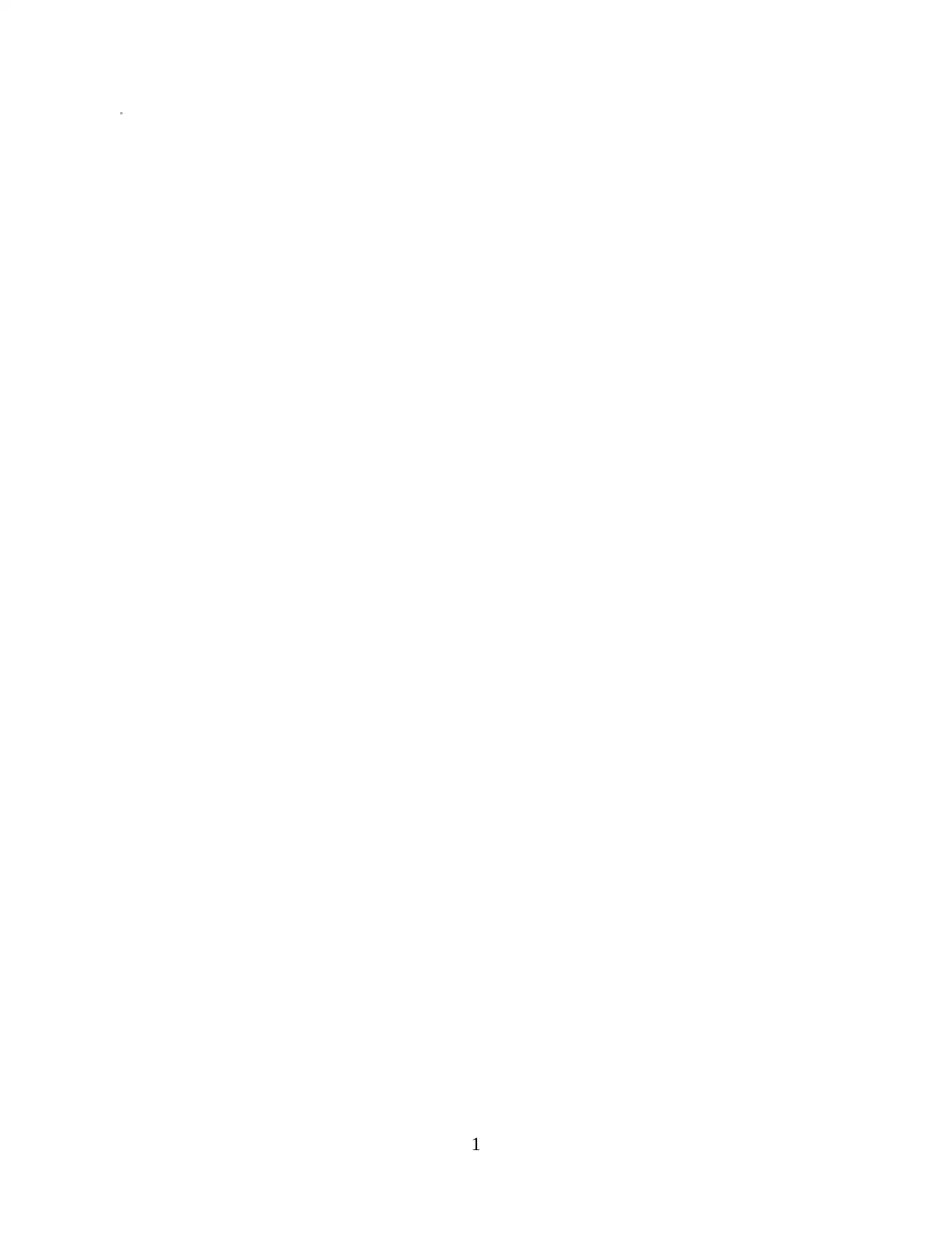
1
1 out of 10
Related Documents
Your All-in-One AI-Powered Toolkit for Academic Success.
+13062052269
info@desklib.com
Available 24*7 on WhatsApp / Email
![[object Object]](/_next/static/media/star-bottom.7253800d.svg)
Unlock your academic potential
© 2024 | Zucol Services PVT LTD | All rights reserved.





